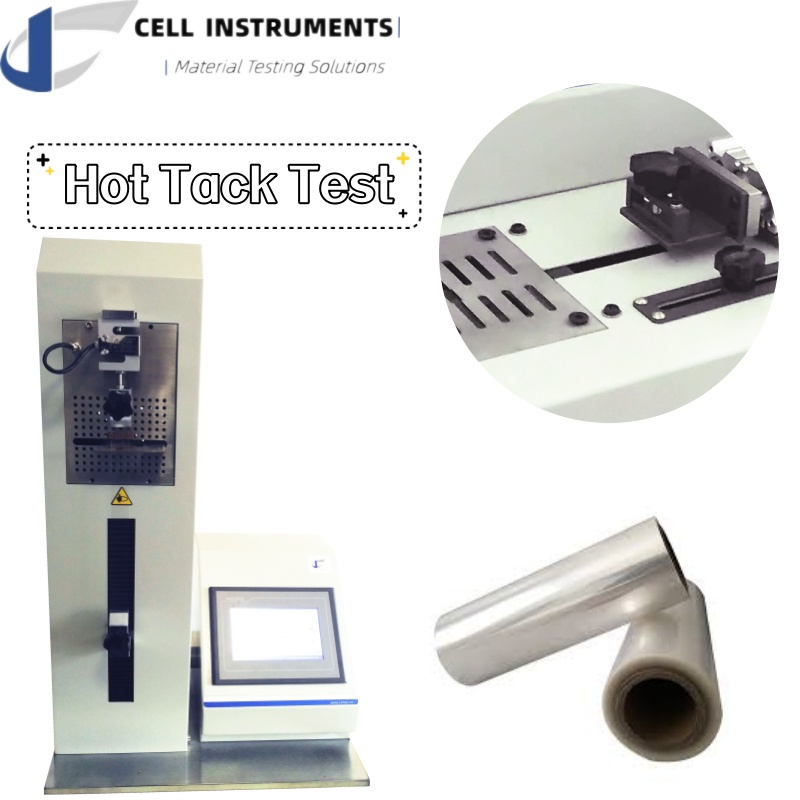In the realm of material testing, particularly for flexible packaging, the hot tack test stands out as a critical evaluation method. This article will delve into the significance of hot tack testing, referencing standards such as ASTM F1921 and ASTM F2029, to provide a comprehensive understanding. Additionally, we'll highlight Cell Instruments' Hot Tack Tester and its applications, ensuring you gain valuable insights into the testing process and its benefits.
Hot tack testing is an essential method used to measure the strength of a heat seal as it cools, specifically in the molten or semi-molten state. This test is crucial for flexible packaging materials, as it determines the ability of packaging to maintain its integrity during the sealing process. Hot tack testing is particularly important for industries where packaging efficiency and reliability are paramount, such as food, pharmaceuticals, and medical devices.
Flexible packaging materials are widely used due to their versatility, cost-effectiveness, and ability to preserve product quality. However, the performance of these materials heavily relies on the strength and reliability of their heat seals. A weak seal can lead to product contamination, spoilage, and ultimately, financial losses. Hence, hot tack testing becomes indispensable to ensure that the packaging meets the required standards of strength and durability.
ASTM F1921 and ASTM F2029 are the primary standards that guide the hot tack testing process. These standards provide detailed procedures and specifications to ensure consistency and reliability in testing.
ASTM F1921 outlines the test method for determining the hot tack force of heat seals for flexible packages. It specifies the equipment, sample preparation, and testing conditions necessary to obtain accurate and reproducible results. This standard ensures that the hot tack test is conducted uniformly across different laboratories and industries.
ASTM F2029 complements ASTM F1921 by providing additional guidelines for evaluating the hot tack properties of heat seals. It includes specific instructions on the preparation of test specimens, the testing apparatus, and the interpretation of results. By adhering to these standards, manufacturers can guarantee the quality and performance of their flexible packaging materials.

To meet the rigorous demands of hot tack testing, Cell Instruments offers a state-of-the-art Hot Tack Tester designed for precision and reliability. Our Hot Tack Tester is equipped with advanced features that ensure accurate measurement of the heat seal strength during the critical cooling phase. Here are some of the key features of our Hot Tack Tester:
Accurate Measurement: Our tester provides precise measurements of hot tack strength, ensuring reliable data for quality control.
User-Friendly Interface: The intuitive interface makes it easy to set up and conduct tests, reducing the learning curve for operators.
Compliance with Standards: Our Hot Tack Tester fully complies with ASTM F1921 and ASTM F2029 standards, guaranteeing that your testing procedures meet industry benchmarks.
Customizable Settings: The tester allows customization of testing parameters to accommodate various materials and sealing conditions.
Robust Construction: Designed for durability, our tester ensures long-term performance even in demanding testing environments.
Hot tack testing is widely used across various industries to ensure the quality and reliability of flexible packaging. Some of the key applications include:
Food Packaging: Ensures that heat seals maintain integrity during packaging, preventing contamination and spoilage.
Pharmaceuticals: Verifies the strength of seals to maintain the sterility and safety of medical products.
Medical Devices: Ensures that packaging for medical devices is secure and tamper-evident.
Textiles: Tests the heat seals in textile packaging to ensure durability and strength.
Electronics: Ensures that flexible packaging for electronic components provides adequate protection.
Previous: Portable Hardness Tester
Next: Zinc Selenide Optics
Copyright:@2020-2021
Comments Please sign in or sign up to post.
0
0 of 500 characters used